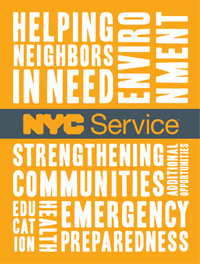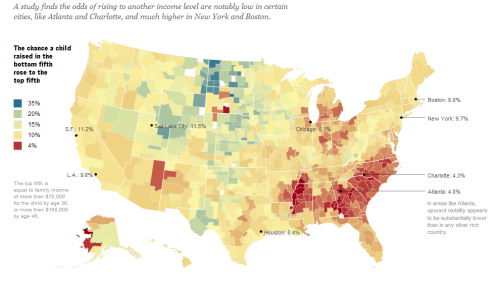
Connector Project
People frequently ask me of examples of city-wide efforts to build social capital. The are several examples in Better Together of Tupelo, MS and what Portland did with city boundaries. Beyond this, Seattle had an interesting program called the Seattle Department of Neighborhoods’ Neighborhood Matching Fund (that provided mini-grants for neighborhood improvement efforts where residents provided matching sweat equity), Minneapolis’ Neighborhood Revitalization Program (where city power was devolved to local neighborhoods to set priorities), and the interesting Front Porch Alliance under Indianapolis Mayor Steve Goldsmith (which has not been as vigorously advocated in subsequent administrations).

NYC Service
I’m aware of several more contemporary examples: NYC Service (and the Cities of Service effort to replicate this), Philadelphia’s Connector Program, and Social Capital, Inc.
NYC Service
Inspired by President Obama’s call for a new era of service, Mayor Bloomberg in his January 2009 State of the City address announced that New York City would lead the way in responding.
After consulting with volunteer groups that worked in the arts, with students, and with seniors to learn what was most needed, they launched NYC Service with Diahann Billings-Burford as their inaugural Chief Service Officer. NYC Service would enable NYC to do more with less (since economic times were tight) and help harness volunteers in “impact service”.
NYC Service, in its several years, has achieved impressive results. They have used citizens to vaccinate over half a million individuals against H1N1; engaged over 400,000 students in school-based volunteering; trained over 10,000 people in CPR who then trained additional New Yorkers; and coated two million square feet of rooftop under their “Cool Roofs” program with reflective white material to lower building’s cooling costs in the summer and help alleviate global warming.
They also launched the Civic Corps, a full-time group of AmeriCorps stipended volunteers who work in the Mayor’s Office or with city non-profits to help those non-profits mobilize volunteers. The Civic Corps in FY11 recruited almost three quarters of a million volunteers, raised $1 million in cash and $6 million in non-cash donations, such as professional services, clothing, food and books.
Over 2,500 volunteer opportunities have been posted to NYC Service (their volunteer clearinghouse website) and they have garnered over 600,000 unique website visitors looking for volunteer opportunities. Between their website and the Civic Corps, NYC Service has mobilized over a million NYC volunteers.
Although NYC Service does not directly track this, one of the most important outcomes (above and beyond how many success mentors they train or how many square feet of roofs they paint white), is the social capital and civic engagement that NYC Service instills. Studies have shown that for many governmental objectives (say keeping streets safe or increasing academic performance), a civic engagement strategy (through neighbors knowing each others’ first names or parents being more involved in their kids’ learning) is more efficacious than a top-down government-funded approach.
NYC Service is undoubtedly increasing citizens’ sense of efficacy (that they can and are making a difference on issues like the environment or school readiness or dealing with truancy). This increased efficacy is likely to cause more New Yorkers to intervene elsewhere (e.g., when someone has fallen on a street or is having a heart attack, or when a neighbor needs assistance).
Implicitly, much of what government does is remediating for gaps in civil society. For example, social service and safety nets step in where family and neighbors don’t. Police are necessary where social sanction and control is insufficient to police social norms. Paid Fire Departments are needed when all-volunteer fire departments can’t fulfill their duties.
The social capital created by NYC Service is likely to have a significant impact, way above and beyond the value of volunteer hours (which are important and sizeable in-and-of themselves). Greater local participation down the road is likely to lead to: a) better crafted and more responsive local policies; b) better performing and less corrupt government since the civic engagement and transparency will hold government officials accountable; c) greater net ability to change citizen behavior relative to an approach that relies on mandates (which are harder to get enacted and less popular); and d) potentially less of a need for government down the road, if engaged citizens do their jobs effectively.
Replication of NYC Service: NYC Service is already being replicated. Mayor Bloomberg held a competition (funded by Rockefeller) and a selection panel chose 10 cities from the cities that applied in June 2010. These winners received $200,000 each to cover some of costs of a Chief Service Officer (which they had to hire) and received wraparound technical assistance (with work-planning, and project management). Rockefeller and Bloomberg Philanthropies announced a second grant round with 10 winners and awarded them in June 2010.
Bloomberg Philanthropies created a “learning community” around these 20 cities [see Cities of Service] with the goal of cross-fertilizing learning, experience sharing, and developing best practices. The CSOs came together face-to-face 2-3 times during the first year, engage in bi-weekly group conference calls, and receive individual technical assistance.
Bloomberg Philanthropies created a “Cities of Service Playbook” that specifies a process they recommend for Cities of Service in coming up with a service plan. CSOs in the first round were hired by May 2010 and these 10 were first convened in June 2010 and provided technical assistance. The first group developed service plans in Sept. 2010. The second group developed service plans by March 2011. [The first group consisted of Chicago, Detroit, Los Angeles, Nashville, Newark, Omaha, Philadelphia, Sacramento, Savannah and Seattle. The second group consisted of Atlanta, Austin, Baltimore, Baton Rouge, Chula Vista, Houston, Little Rock, Orlando, Pittsburgh, and Richmond.]
New cities have also agreed to develop high-impact service plans that were not grantees in these two competitive rounds. Some of the original cities now have the CSO position supported by their budget or have indicated they will include the CSO in their budget.
We’ll look forward to hearing more about NYC Service and their replication efforts.
Philadelphia’s Connector Program:
Started by Liz Dow in 2005 as the Connector Project and based on Bowling Alone and Malcolm Gladwell’s work on connectors and the Tipping Point, they are now in their third iteration, and have renamed themselves Creative Connectors. They identify leaders who use arts, culture and design to build community and create economic vitality. Liz was struck by the observation in Malcolm Gladwell’s “Six Degrees of Lois Weisberg” that “poverty is not deprivation, it is isolation.”
From their three years they have identified 10 traits in connectors (what they call “the Connector Competency Model”) and convened these connectors to connect them with each other.
Liz wrote up her experience in 6 Degrees of Connection and a fuller description of the ten competencies which cutely spell out “CONNECTORS”:
- C: Community Catalyst
- O: Other-oriented
- N: Network Hub
- N: Navigating Mazes
- E: Empowering Passion
- C: Constantly Curious
- T: Trustworthy
- O: Optimistic
- R: Results Achiever
- S: Self-Starter.
The list of creative connectors was generated by an online survey circulated by partner organizations and through an article in the Philadelphia Inquirer. While these connectors are important in Philadelphia, 3 out of 4 of the leaders identified had moved to Philadelphia from somewhere else, and they generally work in the non-profit sector. Creative Connectors also looks for leaders who:
- “are hubs of trust, seen as trustworthy and credible.
- use art and design to mobilize people around an issue.
- foster one-to-one linkages among people they know.
- engage with diverse groups.
- consider the common good as well as personal agendas.
- convey a vision that generates excitement.
- think strategically, act decisively.
- have founded an organization or program.”
Each Connector was profiled and NPR will do a video on each one weekly over the next year.
Philadelphia’s Creative Connectors is being replicated by some other groups including Leadership Louisville and the Portland Connector Project. [And I’ve learned that a Boston connector network already exists, no relation to the effort in Philadelphia, see comment below about Boston World Partnerships.]
Last week, Leadership Philadelphia convened all of the Connectors since 2005 to thank them for their contribution to the community, to connect them with the newest connectors, to have them brainstorm on an issue raised in Knight’s Soul of the Community report, and to send them out into the community to make a Pay It Forward contribution. The latter was a gift of $50 cash with the instruction that they give it to someone in Philadelphia who needs it, and to report back to Leadership, stirring up some grassroots goodwill during the holidays.
Leadership Philadelphia has also initiated a This I Believe project, partnering with the local NPR station to have leaders and then other citizens write and then read their belief statements on air.
Read a news report on their most recent meeting of all their Connectors. The group that launched Creative Connectors, Leadership Philadelphia has a website here. The Connector Project website available here.

Social Capital, Inc.
Inspired by reading Bowling Alone, David Crowley, whom I regard as an unofficial mayor of social capital, decided to launch Social Capital, Inc.
David was moving to Woburn, MA (his home town) at the same time as he was inspired to see what he could do at a local level to rebuild social capital. He launched SCI and focused on trying to increase social capital in Woburn.
As David puts it: “The process of reconnecting to his home community after some 12 years of living elsewhere provided tangible examples of barriers to building social capital in today’s society, but also suggested that there were many community assets that could be harnessed through collaborative, community-wide social capital building initiative. The basic idea of developing a local model that could be replicated in order to address the decline of social capital and civic engagement was born.”
SCI Woburn was launched in summer 2002. In 2004, SCI expanded to Dorchester and in 2006-07, SCI began work in Lynn. They have now expanded to Fall River and Milford.
SCI sees their mission as developing new “social capitalists” and believes it can train young people in the “unique set of skills and attitudes that enables them to collaborate effectively, make connections, bridge differences, and nurture social networks to make a difference. David is an ardent evangelist for social capital. They are in the process of developing tools for would-be social capitalists and we will let you know when those become available.
In 2010-2011, here are some of SCI’s accomplishments.
- SCI AmeriCorps members recruited over 2,500 community volunteers and a almost 70,000 residents of Dorchester, Boston, Fall River, Milford, Lynn and Woburn have benefitted from their service. The AmeriCorps members & volunteers served almost 50,000 hours with a market value of $1.25 million (based on Independent Sector’s rates for volunteer service)
- 240 youth and other emerging leaders developed Social Capitalist skills with SCI this year.
- Over 4,015 food & clothing items have been generated by SCI AmeriCorps members and volunteers for people in need during these difficult economic times.
- Over 12,500 individuals use an SCI community portal every month to connect with local civic happenings.











